|
OKoffroad.com ó 4x4 Editorial |
|
. |
| . |
 |
by Kevin Yeager
reprinted with permission |
While on the recent Poker Run trail ride, we had to use a
recovery strap or winch several times to get someone unstuck. The thought occurred to me - how
often should we check this equipment to verify its condition and proper operation? Some say,
before each trip. Others say, a few times each wheeling season. And still others say, just
once a year at the beginning of the wheeling season. So whoís right?
The answer - they all are. Let me explain.
At the beginning of each wheeling season or, if you wheel year round, once a year lay out all of
your recovery gear and inspect it. This includes unspooling your winch cable even if it hasnít
been used during the past year. Then as you go through the season, whenever you use a piece of
your equipment out on the trail be sure to look it over before stowing it back in your rig. That
way, if it is damaged, you will know not to use it again during the run and that it needs to be
replaced when you get home.
Before each trip you should verify that you have each piece of recovery gear that you normally
carry. Donít just look to see that your recovery pack is in your rig. Open it up and verify
that all of your equipment is there. You may have forgotten to replace something that was
damaged or that strap you loaned out, to an ill-equipped wheeler, that didnít get returned. By
checking every item, you wonít find yourself shorthanded out on the trail.

What you need to look for as you inspect you equipment.
If you own a winch, check it for both power in and power out (some older winches -very old -
donít have power out capability). Make sure that the free spool and brake work too. If your
winch is of the PTO design (power take off) then youíll have to check the PTO components, the
PTO gearbox (on the transmission or transfer case) and drive shafts also to ensure theyíre in
good working condition.

The cable should be inspected for crushed/pinched spots, frays and kinks. While some say that
minor crushed/pinched spots and frays can be monitored for a while until they become bad enough
that you need to shorten or replace the cable to eliminate them. I believe in erring on the
side of safety and shorten or replace the cable for all but very minor damage. And about kinks -
there is no such beast as a minor kink in a cable, they must be removed by either shortening or
replacing your cable.
If you have to shorten the cable, there are 2 ways to do it. The first, is to have a shop that
has the right equipment do it, using a swage collar to make the loop in the end of the cable.
This way looks just like what your winch had from the manufacturer and retains 100% of the
cableís working load.
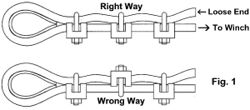
The second way is to use cable clamps, some times call cable clips, and do it yourself. There is
a right way and a wrong way to do this. The right retains about 80% of your cableís working load.
The wrong way retains only about 40% of your cableís working load.
D-ring shackles stretch before they break. The loop part of the shackle, normally 2/3 of a
circle, stretches into an oval shape. Another indication that a shackle may have been over
stressed is, if the screw pinís threads bottom out before the head of the screw pin tightens up
to the nonthreaded side of the loop. Snatch blocks (or winching pulleys) also should be checked
and lubed.
|
. |

reprinted with permission
Nylon Webbing
Tow straps, recovery straps (tug-em & yank straps) and tree savers all have the same concerns
when youíre inspecting them. Look for cuts, frays, tears, loose stitching and dirt.
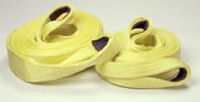
Why dirt? While wheeling in the mud it is impossible to keep your straps clean when using them.
Dirt and sand are abrasives. When dirt and sand get into the weave of a nylon strap, they start
cutting and damaging the fibers of the strap. This can lead to premature failure of the strap.
Muddy or dirty nylon straps should be washed in mild soap and water and be thoroughly rinsed. At
the least, a dirty strap should be rinsed clean of the dirt and mud. Then air dry it in the
shade.

Hi-Lift Jack
The Hi-Lift (a registered brand name) or farm jack is one of the most versatile pieces of
recovery gear that you can carry in your 4x4. The parts that you need to look at are the
climbing pins, the cross pins (they go through the climbing pins), the reversing mechanism and
the running gear (the lifting part of the jack). Look for any wear or damage and lubricate all
of the moving parts with a water resistant grease. If the climbing pins or cross pins need
replacing, Hi-Lift offers a repair kit that works on most, if not all, jacks of this design. The
rest of the jack should be in good condition, straight with no extra vehicle parts welded to it.
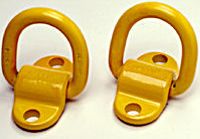
Recovery Points
The last piece of equipment to inspect is your vehicle. Thatís right - your vehicle. You should
have 2 solid recovery points, one on the front and one on the rear of your vehicle. These
(tow hooks, loops, rings or eyelets for shackles) need to be securely mounted to the frame and
strong enough to handle more than the heaviest pull that your rig would need or give. If you have
tow hooks, they should have retention clips on them. These retention clips prevent the recovery
strap from falling off the hook when the strap goes slack.
Inspect the area of the frame to which the recovery points are attached for deformation and
cracks. Any problems here should be repaired by certified personnel to ensure that maximum
strength is retained or restored. Also, check the recovery point and its attaching hardware for
damage or signs of fatigue.
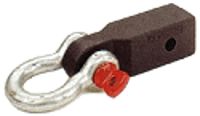
Receiver Hitch
While a class III receiver hitch (with its hitch pin) qualifies as a rear recovery point at most
OHV events, you should note that it is only rated at 5000Lbs towing capacity. So, if you plan to
use it, make sure that it far exceeds the strength requirements for a class III hitch or be very
cautious when using it as an attaching point for vehicle recovery.
|
. |
Courtesy of Peterson's 4-Wheel & Off-Road
|
|
. |
Fourwheeling for me:
"My escape from the working world, all the stress from the rest of life, thank goodness for
my fj40!"
Scott Paswaters
Holladay, Utah |
|
. |
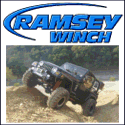


|
|





